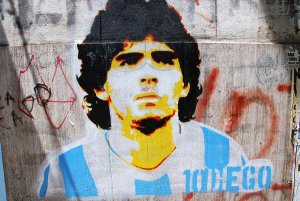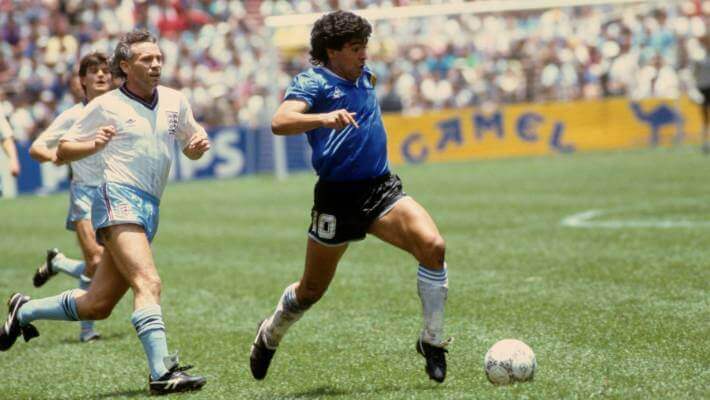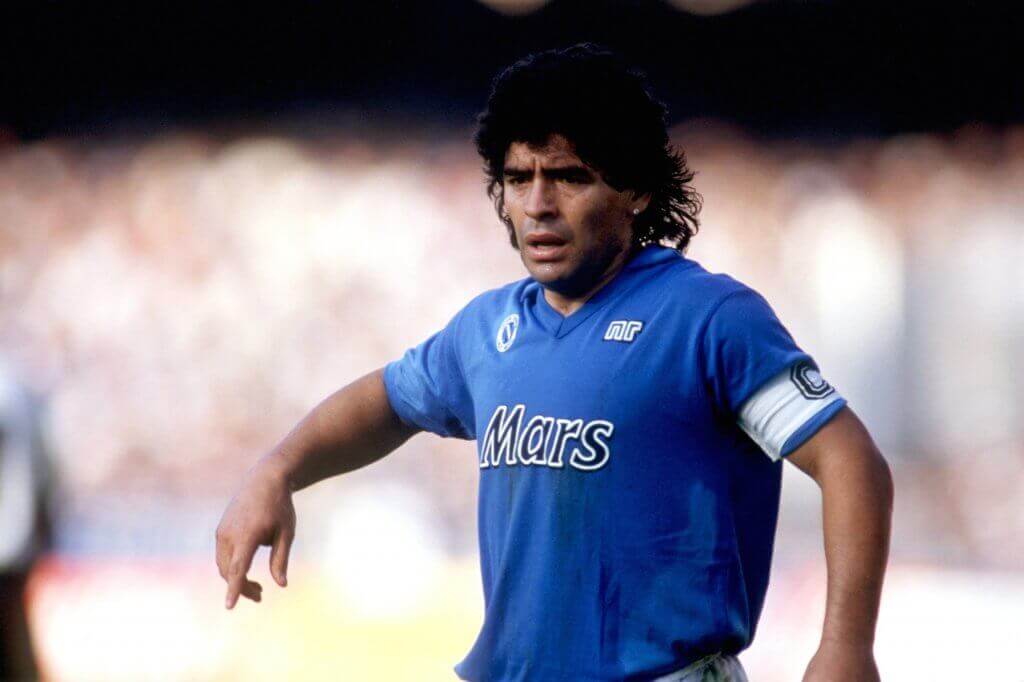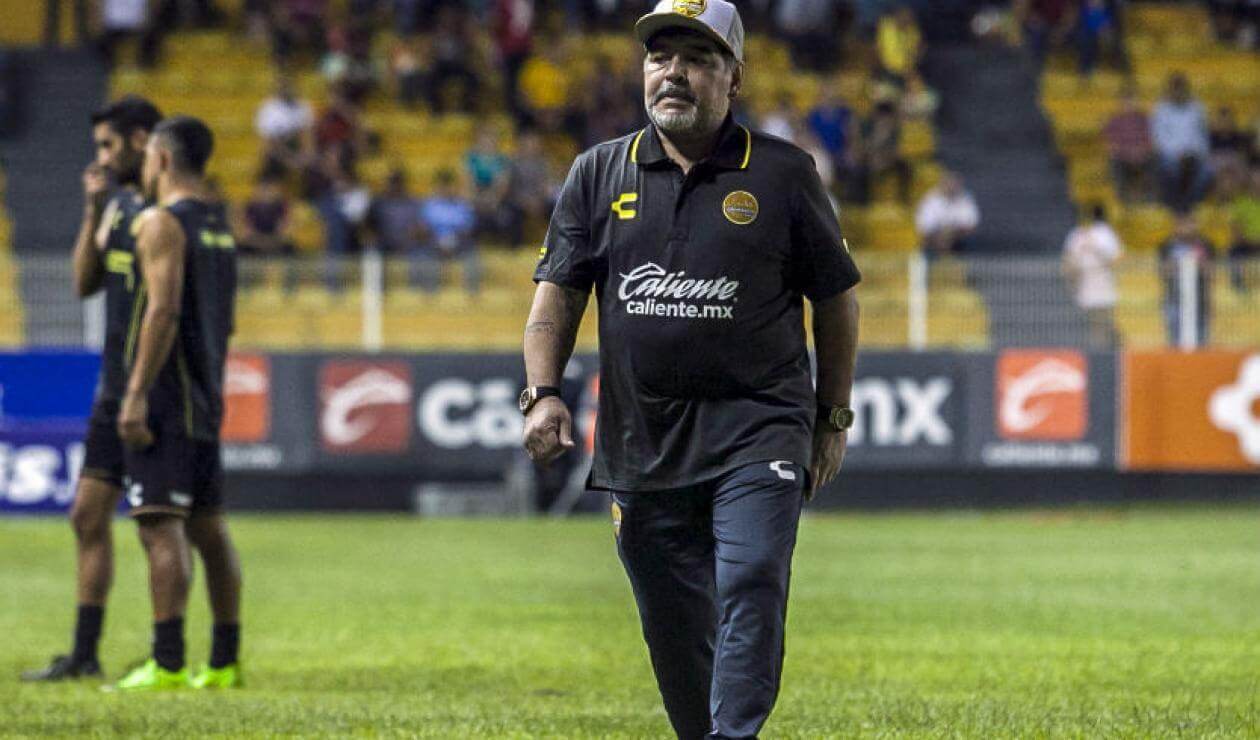Diego Maradona: One of the Greatest of All Time

Diego Armando Maradona was truly one of the greats in all of Soccer history. In today’s post, let’s take a look at the Argentinian legend’s biggest feats.
There isn’t a corner of the world that doesn’t know who Diego Maradona is. While he was always a flamboyant guy who loved being the center of attention for better or worse, nobody can deny his talent.
Maradona is a legend in soccer history, especially in Argentina and Naples, Italy. He made a name for himself with his footwork, impossible goals, and controversial comments. For today’s post, we’ve tackled the titanic task of summarizing Maradona’s sporting career.
The glory of Diego Maradona
No summary of his accomplishments would be complete without considering how he was as a soccer player. Left-handed, skilled, small yet powerful and with an unparalleled ability to read the game, Maradona always carried his teams to top ranks.
His best seasons were on the Argentinian national team. Although he couldn’t play on the team that won the 1978 Argentina World Cup, he didn’t falter in creating an incredible soccer career. Just one year later, he won the FIFA U-20 World Cup donning his country’s colors.
He played in his first World Cup in 1982, Spain but the Argentina national team failed to impress. However, in the 1986 Mexico World Cup, he carved his name in stone along with soccer’s other greats.
It was in the quarter-finals when Maradona shot the best goal in World Cup history. Uruguayan journalist Victor Hugo Morales described his amazing 11-second long run, leaving six opponents behind as, “pure soccer genius”.

As if that wasn’t enough, in the same game he scored another goal with his hand, which the referee deemed valid. As a result, Argentina beat the UK 2-1, with whom it was also fighting against in the Falklands War. The game immortalized Maradona as the avenger that the whole world was waiting for.
The teams he played on
The Argentinian soccer star also played on many teams. At the beginning of his career, he debuted professionally with the Argentino Juniors in 1976. After, he was traded to a team he very much admired, the Boca Juniors, despite the fact that other teams offered better deals.
Years later in 1982, FC Barcelona bought Maradona for a record-breaking amount of money at that time. However, Basque player Antoni Goikoetxea would injure him badly later on and the recovery on top of appendicitis and hepatitis created serious obstacles in his career.
In the Copa del Rey finals of 1983, Maradona came face to face again with the man who kept him off the fields for three months and a half– Goikoetxea. Their re-encounter was explosive and resulted in the suspension of various players. Among them, was Maradona. His three-month ban led to the end of this time on Barcelona.
He was sold to Naples, where he won a Scudetto, a Coppa Italia championship and a EUFA cup as well. Before he joined the team, Naples often struggled to maintain their division status. But Maradona’s incorporation changed their situation entirely, pushing them to be the solid team that they still continue to be today.

The last European team he played for was Seville. Without making too much of a splash on the team, he returned to Argentina to play on the Newell’s Old Boys, which was the same team Messi started his career on. After his doping ban in 1994, Maradona donned the Boca’s jersey again before retiring in 1998.
Doping “clipped his legs”
Though the drug he took is no longer considered doping by today’s standards, in the 1994 United States World Cup Maradona tested positive for doping and other substances as well. When caught, he stated that doping “clipped his legs”, which continues to be a famous statement even today.
The Argentina national team, which stood proudly in 1st place in 1986, and in 2nd in 1990 Italy, fell to their defeat in the round of sixteen against Romania. The players complained that Maradona’s ordeal, which involved years of drug-usage since his time in Barcelona, sunk the team’s morale.
Diego Maradona retires from the game and moves on to coaching and other leads
After he left the pitch, Maradona moved on to different roles. He was a coach– up until very recently–, vice president of Boca, sports commentator and TV show host. In addition, he starred in many advertisements.

In addition, since Gianni Infantino became the president of FIFA, Maradona as also joined the group of former soccer stars that host FIFA celebrations. Unlike Infantino, Maradona always had a poor relationship with former FIFA president Joseph Blatter. In fact, Maradona always attacked him publicly whenever the opportunity presented itself.
As for Maradona’s personal life, his drug addiction was a reoccurring theme. He found himself in sticky situations on more than one occasion. Furthermore, his flings, and the resulting children he refused to acknowledge clouded his public image. However, he’s still loved by soccer fans.
With his talent and mistakes, Diego Maradona had an extraordinary sporting career that extended far past his time as an actual player. Ever since he hung up his shoes, his human-side became more and more apparent: the problems and failures piled up and cost him greatly. But just as Maradona himself said on the day he retired, “The game is still pure” (“la pelota no se mancha“).
Diego Armando Maradona was truly one of the greats in all of Soccer history. In today’s post, let’s take a look at the Argentinian legend’s biggest feats.
There isn’t a corner of the world that doesn’t know who Diego Maradona is. While he was always a flamboyant guy who loved being the center of attention for better or worse, nobody can deny his talent.
Maradona is a legend in soccer history, especially in Argentina and Naples, Italy. He made a name for himself with his footwork, impossible goals, and controversial comments. For today’s post, we’ve tackled the titanic task of summarizing Maradona’s sporting career.
The glory of Diego Maradona
No summary of his accomplishments would be complete without considering how he was as a soccer player. Left-handed, skilled, small yet powerful and with an unparalleled ability to read the game, Maradona always carried his teams to top ranks.
His best seasons were on the Argentinian national team. Although he couldn’t play on the team that won the 1978 Argentina World Cup, he didn’t falter in creating an incredible soccer career. Just one year later, he won the FIFA U-20 World Cup donning his country’s colors.
He played in his first World Cup in 1982, Spain but the Argentina national team failed to impress. However, in the 1986 Mexico World Cup, he carved his name in stone along with soccer’s other greats.
It was in the quarter-finals when Maradona shot the best goal in World Cup history. Uruguayan journalist Victor Hugo Morales described his amazing 11-second long run, leaving six opponents behind as, “pure soccer genius”.

As if that wasn’t enough, in the same game he scored another goal with his hand, which the referee deemed valid. As a result, Argentina beat the UK 2-1, with whom it was also fighting against in the Falklands War. The game immortalized Maradona as the avenger that the whole world was waiting for.
The teams he played on
The Argentinian soccer star also played on many teams. At the beginning of his career, he debuted professionally with the Argentino Juniors in 1976. After, he was traded to a team he very much admired, the Boca Juniors, despite the fact that other teams offered better deals.
Years later in 1982, FC Barcelona bought Maradona for a record-breaking amount of money at that time. However, Basque player Antoni Goikoetxea would injure him badly later on and the recovery on top of appendicitis and hepatitis created serious obstacles in his career.
In the Copa del Rey finals of 1983, Maradona came face to face again with the man who kept him off the fields for three months and a half– Goikoetxea. Their re-encounter was explosive and resulted in the suspension of various players. Among them, was Maradona. His three-month ban led to the end of this time on Barcelona.
He was sold to Naples, where he won a Scudetto, a Coppa Italia championship and a EUFA cup as well. Before he joined the team, Naples often struggled to maintain their division status. But Maradona’s incorporation changed their situation entirely, pushing them to be the solid team that they still continue to be today.

The last European team he played for was Seville. Without making too much of a splash on the team, he returned to Argentina to play on the Newell’s Old Boys, which was the same team Messi started his career on. After his doping ban in 1994, Maradona donned the Boca’s jersey again before retiring in 1998.
Doping “clipped his legs”
Though the drug he took is no longer considered doping by today’s standards, in the 1994 United States World Cup Maradona tested positive for doping and other substances as well. When caught, he stated that doping “clipped his legs”, which continues to be a famous statement even today.
The Argentina national team, which stood proudly in 1st place in 1986, and in 2nd in 1990 Italy, fell to their defeat in the round of sixteen against Romania. The players complained that Maradona’s ordeal, which involved years of drug-usage since his time in Barcelona, sunk the team’s morale.
Diego Maradona retires from the game and moves on to coaching and other leads
After he left the pitch, Maradona moved on to different roles. He was a coach– up until very recently–, vice president of Boca, sports commentator and TV show host. In addition, he starred in many advertisements.

In addition, since Gianni Infantino became the president of FIFA, Maradona as also joined the group of former soccer stars that host FIFA celebrations. Unlike Infantino, Maradona always had a poor relationship with former FIFA president Joseph Blatter. In fact, Maradona always attacked him publicly whenever the opportunity presented itself.
As for Maradona’s personal life, his drug addiction was a reoccurring theme. He found himself in sticky situations on more than one occasion. Furthermore, his flings, and the resulting children he refused to acknowledge clouded his public image. However, he’s still loved by soccer fans.
With his talent and mistakes, Diego Maradona had an extraordinary sporting career that extended far past his time as an actual player. Ever since he hung up his shoes, his human-side became more and more apparent: the problems and failures piled up and cost him greatly. But just as Maradona himself said on the day he retired, “The game is still pure” (“la pelota no se mancha“).
All cited sources were thoroughly reviewed by our team to ensure their quality, reliability, currency, and validity. The bibliography of this article was considered reliable and of academic or scientific accuracy.
- Bialo, C. 2019. La droga que Maradona tomó en el Mundial de Estados Unidos hace 25 años hoy no sería doping. Infobae. https://www.infobae.com/deportes-2/2019/06/23/la-droga-que-maradona-tomo-en-el-mundial-de-estados-unidos-hace-25-anos-hoy-no-seria-doping/
- Diego Armando Maradona. Wikipedia. https://es.wikipedia.org/wiki/Diego_Armando_Maradona#La_consagraci%C3%B3n_en_N%C3%A1poles_(1986-1990)
This text is provided for informational purposes only and does not replace consultation with a professional. If in doubt, consult your specialist.








